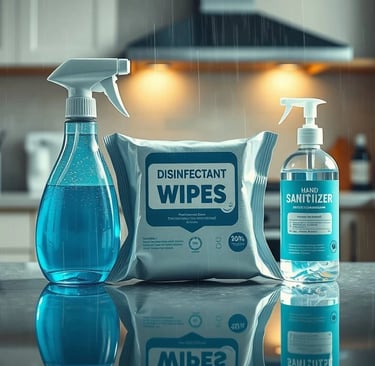Cleaner vs Disinfectant vs Sanitizer: What's the Difference?


Cleaner vs Disinfectant vs Sanitizer: What's the Difference?
When you're shopping for household cleaning products, you've probably noticed terms like "cleaner," "disinfectant," and "sanitizer" used everywhere. But what exactly is the difference between these products? Understanding these distinctions can help you choose the right product for each cleaning task and keep your home truly clean and safe.
What is a Cleaner?
A cleaner is designed to remove dirt, grime, grease, and other visible debris from surfaces. Cleaners work by breaking down and lifting away particles so they can be wiped or rinsed away. Think of your everyday glass cleaner, all-purpose cleaner, or dish soap – these are all examples of cleaners.
What cleaners do:
Remove visible dirt and debris
Break down grease and grime
Make surfaces look clean and fresh
Remove odors caused by dirt buildup
What cleaners don't do:
Kill germs, bacteria, or viruses
Provide any antimicrobial protection
Cleaners are perfect for regular maintenance cleaning when your goal is simply to make things look and feel clean. However, if you're concerned about germs and bacteria, you'll need something stronger.
What is a Disinfectant?
Disinfectants are chemical products specifically designed to kill or inactivate microorganisms like bacteria, viruses, and fungi on surfaces. The EPA regulates disinfectants and requires them to prove they can eliminate specific percentages of germs within a certain timeframe.
What disinfectants do:
Kill 99.9% of bacteria and viruses
Destroy harmful microorganisms like E. coli, salmonella, and influenza
Provide the highest level of germ-killing power
Meet strict EPA standards for antimicrobial effectiveness
Important note about disinfectants:
Most disinfectants require a "contact time" – meaning the product must remain on the surface for a specific period (usually 30 seconds to 10 minutes) to effectively kill germs. Always check the product label for proper usage instructions.
Disinfectants are ideal for high-touch surfaces like doorknobs, light switches, and bathroom fixtures, especially during flu season or when someone in your household is sick.
What is a Sanitizer?
Sanitizers fall somewhere between cleaners and disinfectants in terms of germ-killing power. They reduce the number of bacteria on surfaces to levels considered safe by public health standards, but they don't necessarily kill all types of germs like disinfectants do.
What sanitizers do:
Reduce bacteria by 99.9% within 30 seconds
Work faster than most disinfectants
Provide quick antimicrobial action
Often contain alcohol as the active ingredient
What sanitizers don't do:
Kill all types of viruses and fungi (like disinfectants do)
Provide long-lasting antimicrobial protection
Hand sanitizers are the most common example, but surface sanitizers are also available for quick cleaning of areas like kitchen counters or children's toys.
When to Use Each Product
Use Cleaners When:
Doing routine housekeeping
Surfaces are visibly dirty or greasy
You need to remove odors
Preparing surfaces before disinfecting (clean first, then disinfect)
Use Disinfectants When:
Someone in your home is sick
Cleaning areas where raw meat was prepared
High-touch surfaces need deep germ protection
During cold and flu season
Cleaning bathrooms and other germ-prone areas
Use Sanitizers When:
You need quick germ reduction
Cleaning hands when soap isn't available
Light cleaning of food contact surfaces
Quick touch-ups between deep cleaning sessions
Can Products Do Multiple Jobs?
Many modern cleaning products combine functions. You'll find:
All-in-one cleaners that clean and disinfect in one step
Disinfecting wipes that remove dirt while killing germs
Sanitizing sprays that clean light soil while reducing bacteria
Always read product labels carefully to understand exactly what each product does and follow usage instructions for maximum effectiveness.
The Bottom Line
Understanding the difference between cleaners, disinfectants, and sanitizers helps you make smarter choices for your home. For the best protection, many cleaning experts recommend a two-step process: clean first to remove visible dirt, then disinfect to kill germs. This approach ensures both a clean appearance and maximum germ protection for your family.
Remember, the most effective cleaning routine uses the right product for each specific task. By choosing appropriately, you'll maintain a home that's not just clean-looking, but genuinely clean and safe.
FAQs
Do I need to disinfect every day?
Usually no. Routine cleaning is enough for low-risk households. Disinfect when someone is ill or when you need targeted germ control on high-touch surfaces.
Are disinfecting wipes safe on food-prep surfaces?
Often they are not “no-rinse” for food-prep areas. Check the label. Many wipes require a potable water rinse on food-contact surfaces.
Is a sanitizer the same as a hand sanitizer?
No. Surface sanitizers/disinfectants are regulated by the EPA. Hand sanitizers are for skin, regulated by the FDA. Don’t use surface disinfectants on skin.
Can I sanitize or disinfect soft surfaces like couches?
Some products have “soft surface sanitizer” claims (reduces bacteria). True disinfection is generally for hard, nonporous surfaces. For fabrics: clean and/or launder.
What’s “contact time” and why do my wipes dry out?
Contact time is how long the surface must stay visibly wet to kill the listed germs. For wipes, use enough wipes to keep the surface wet for the full time.
Responsible sources and further reading
U.S. EPA, Antimicrobial Pesticides (sanitizers/disinfectants): https://www.epa.gov/pesticides/antimicrobial-pesticides
EPA List N: Disinfectants for Use Against SARS-CoV-2: https://www.epa.gov/pesticide-registration/list-n-disinfectants-use-against-sars-cov-2
CDC, Cleaning and Disinfecting Your Home: https://www.cdc.gov/hygiene/cleaning/
FDA, Hand Sanitizers (for skin): https://www.fda.gov/drugs/information-consumers-and-patients-drugs/hand-sanitizers


